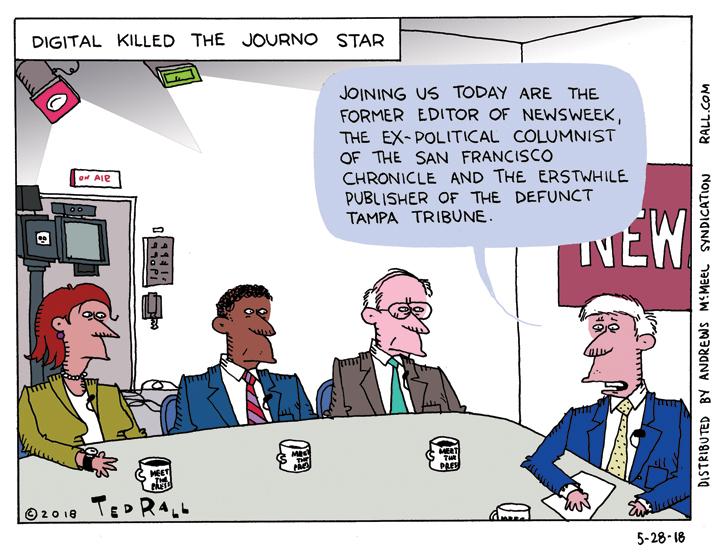 Journalism is in trouble. Writers of articles pointing this out typically argue that this is really bad for democracy or America or whatever. Anyone who disagrees is too stupid to read this so I won’t bother to repeat this obviousness. Such writers also point out contemporaneous evidence of the media apocalypse; here are the three I came across this week.
Journalism is in trouble. Writers of articles pointing this out typically argue that this is really bad for democracy or America or whatever. Anyone who disagrees is too stupid to read this so I won’t bother to repeat this obviousness. Such writers also point out contemporaneous evidence of the media apocalypse; here are the three I came across this week.
1. 1,800 local newspapers have gone out of business in the last 15 years. Since print newspapers generate nine out of ten stories that appear on radio, TV and online, that’s a big loss.
2. The New Orleans Times-Picayune has closed. This is notable because it’s the first time in memory that a major city’s single major daily (OK, thrice weekly in recent years) has vanished. Its smaller Baton Rouge-based competitor remains but now it’s easy to imagine a real city having no daily paper whatsoever.
3. The influential and notably right-before-anyone-else investor Warren Buffett used to believe in newspapers enough that he bought some. No more. Now he says the only viable print papers are the national megapapers The New York Times, Washington Post and Wall Street Journal. (Disclosure: I write op-eds for the Journal.)
At the same time, the Mueller Report was a bestselling book.
A print book.
Note: you can read it for free online.
Why would anyone pay for the Mueller Report? For the same reason they paid to read the 9/11 Commission Report and the Starr Report about Bill Clinton, two other public documents freely available on the Internet that became bestsellers in print form. Which happens to be the same reason magazines like The New Yorker and The Economist make a profit while many others are tanking. It’s also why the Sunday edition of The New York Times does well.
Long stuff is easier to read in print.
Many readers read the Mueller Report on their electronic devices. As evidenced by the success of the book version, however, a lot of people are willing to pay money to avoid the eye and neck strain of peering and craning at a comparatively low-resolution screen—while retaining less of what they read—for more than 400 pages. And that is the future of print journalism.
In the 1970s the weekly news magazines Time, Newsweek and U.S. News & World Report ran long-form analysis of the stories that had been reported the previous week by daily newspapers. Reporters at the newsweeklies dug deep, unearthed new details and told you what it all meant and why it mattered. They were giants, read by tens of millions of Americans.
Beginning with the rise of the Web in the 1990s, the newsweeklies lost their way. Editors thought the Internet proved that our attention spans were shortening so they slashed word counts. Stories got shorter. There were fewer of them too. So people stopped reading them. Why pay for the same content they could get free online, and sooner? Newsweek basically went out of business. U.S. News is online only. Once the cornerstone of Henry Luce’s empire, Time subsists.
The New Yorker and The Economist are prospering because they doubled down on their commitment to detailed long-form journalism about ongoing issues. Graphically they contain no evidence that the Web ever existed. They carry words, lots and lots of them, occasionally punctuated by hand-drawn illustrations. Some articles weigh in at 5,000, even 10,000 words. These publications don’t break news—they can’t. They deep dive.
You already know what happened. Long-form analysis tells you what it means.
Long form, long form, long form. Long form is the future!
Old formats endure because new ones can’t replace desirable functions. Despite expert predictions TV didn’t kill radio because you can’t watch TV while you drive or clean the house. Print is perfect for long-form publishing because many people prefer flipping pages to scrolling. And it’s easier on your eyes.
The future of print—which, digihype aside, is still where the money is to be made—is analogous to the 1970s, when people read daily papers for breaking news and news magazines for long-form analysis. When news breaks we’ll read about it online, on our devices. A new generation of print outlets will supply after-the-fact analysis that go on for thousands of words, along with comix journalism and complicated charts that require days (rather than minutes or hours) to research, compile and edit.
Newspapers, Buffett said, “haven’t figured out a way to make the digital model complement the print model.” It would be nice to suggest that he is mistaken, that beleaguered newspapers will finally pivot to long form, perhaps replacing their current seven-day runs with a single beefy weekend edition. Unfortunately, he’s right.
Newspapers have never been managed by people with less vision. They’ve fired the experienced out-of-the-box thinkers on their staffs in favor of underpaid Millennials who think they can guilt readers into subscribing the way NPR does during their pledge drives. Listeners support NPR because it offers unique content, not because listeners would feel guilty if it went under. Newspapers ought to have figured out long ago that no one will pay for the same exact news that they read yesterday, for free, on their phones.
“Creative destruction” will erase the dinosaurs. In their place will arise a new generation of print outlets dedicated to long-form analysis and commentary.
(Ted Rall, the cartoonist, columnist and graphic novelist, is the author of “Francis: The People’s Pope.” You can support Ted’s hard-hitting political cartoons and columns and see his work first by sponsoring his work on Patreon.)

